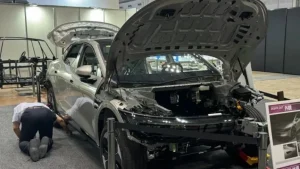NASA Rushing towards China’s Moon Rocks
On April 26, Wuhan, a city in central China known for hosting one of China’s most famous geosciences institution, witnessed the arrival of ten scientists from six countries. As the lucky few who had advanced to to the final round of application for access to lunar samples retrieved by the Chang’e 5 mission, these scientists gathered to present their finalized research plans. Half from the U.S. and the other half from Britain, Germany, France , Japan and Pakistan, these scientists will potentially be part of a collaboration rarely expected in the general environment of Sino-US hostility. One couldn’t help but feel emotional at the collaboration considering how the infamous Wolf Amendment of the U.S. has hitherto prohibited Sino-US collaboration in space science for more than a decade.
 Some might ask, “Didn’t the United States bring back 382 kilograms of lunar soil from the Apollo missions 50 years ago? Why do they have to ask China for it?” Regarding this question, NASA replied as follows: “The Chang’e-5 samples originate from regions of the moon not yet sampled by NASA and are expected to provide valuable new scientific insight on the geological history of the moon, which could provide new understanding of the Earth-moon system and potentially inform NASA’s future lunar exploration plans.”
Some might ask, “Didn’t the United States bring back 382 kilograms of lunar soil from the Apollo missions 50 years ago? Why do they have to ask China for it?” Regarding this question, NASA replied as follows: “The Chang’e-5 samples originate from regions of the moon not yet sampled by NASA and are expected to provide valuable new scientific insight on the geological history of the moon, which could provide new understanding of the Earth-moon system and potentially inform NASA’s future lunar exploration plans.”
 NASA astronaut collects Moon rock during the Apollo 11 mission, which was the very first mission to land astronauts on the Moon
NASA astronaut collects Moon rock during the Apollo 11 mission, which was the very first mission to land astronauts on the Moon
While the US return-to-the-Moon program is set to take place in the Moon’s south pole, the Apollo astronauts only sampled six low and mid-latitude sites on the lunar surface, which renders their findings of limited use considering the vastness and complexity of the Moon surface. Therefore, the US is in an urgent need to gather as much data of the Moon’s soil as possible for its future missions, and could really use the China’s Moon soil samples.

But amidst an escalating Sino-US technological war, with the U.S. going all out on suppressing China’s technological advancement, why would China provide Moon soil samples to American scientists to aid the US’ Moon missions?
Well, one could argue that it is an act of reciprocity as the U.S. has once gifted 1 gram of Apollo Moon sample to China.
Indeed in 1978, on the eve of the establishment of diplomatic relations between China and the US, Brzezinski, the national security adviser to US President Jimmy Carter, presented China with one gram of lunar soil as a gift from the U.S.. China then divided this lunar soil into two parts, of which 0.5 grams were used for scientific research and the other 0.5 grams were kept in the Beijing Planetarium. Fourteen research papers from Chinese scientists, including Ouyang Ziyuan, were based on the precious 0.5 grams of lunar soil.
But the US’ lunar rock comes with a hefty price tag – it represents an olive branch extended for an alliance in the end of 70s against the Soviet Union, in spite of ideological disparities perceived by the U.S.. To counter the enormous pressure from the Soviet Union’s expansion of influence, the U.S. even sold weapons to China as an effort to deepen collaboration. And the dissolution of the Soviet Union in 1991 proved the U.S. successful. It’s safe to say that the US has long been rewarded for this 1 gram sample of Moon soil from a geopolitical perspective, in addition to what China then gifted the U.S. in return as a courtesy. The Chang’e 5 sample should have nothing to do with this episode in history now that nearly half a century has passed.
Some argued that China should gift the U.S. with lunar samples because space exploration is a shared cause for all mankind as science knows no borders. The argument develops as follows: The Outer Space Treaty formulated by the United Nations in 1966 and the Moon Agreement formulated in 1979 stipulate that the Moon and its resources, including Moon soil, are the common property of all mankind used for peaceful purposes. Therefore, it is an obligation required by international law to share lunar soil, as evidenced by the precedent set by the United States Apollo program. Hence, China should follow the example of the United States.
I’d like to refute this argument by delving into the two international treaties mentioned first. The Outer Space Treaty only stipulates in general terms that the Moon and other celestial bodies are the property of all mankind, with all countries enjoying the freedom of scientific investigation. It is Article 6 of the Moon Agreement that specifically addresses the right of signatory countries to collect and remove samples from the moon, as well as the right to dispose of them as they see fit, while also shall have regard to making them available to other signatory countries and the international scientific community for research purposes.
The problem is, China, the United States, Russia and most European countries are not signatory countries to the Moon Agreement, and thus are not bound by its provisions. The accusation that China is breaching the international law of sharing lunar soil is therefore groundless.

So how did NASA distribute Apollo Moon rock and lunar soil samples?
From 1969 to 1972, the six Apollo Moon missions brought back 2,196 rock and soil samples totaling 382 kilograms. These samples were sent to NASA’s Lunar Receiving Laboratory (LRL), built specifically for sample preservation and research, for processing and storage. They were cut into roughly 14,000 more samples in a vacuum or nitrogen-filled environment. Some of them were sealed for future researches when more advanced technology became available. The rest of the samples were turned over to the Astromaterials Research and Exploration Science division at Johnson Space Center after the LRL was shut down.
A few months after the Apollo 11 mission, U.S. President Nixon decided to gift 135 countries in 1970 with lunar samples as a token of good will. The gift consists of a tiny lunar rock with a flag of the receiving country, which had been brought to the moon. It was after the completion of the Apollo 17 mission that the Soviet Union received the gift. It was after Apollo 17 finished its mission when the Soviet Union received the gift. China, on the other hand, did not receive this gift until as late as 1978, likely a result of decisions made during Nixon’s visit to China in 1972.
Excluding those that had been gifted or used in research, NASA reportedly still has 85% of the Apollo lunar samples.
For the remaining unsealed lunar samples, as well as samples of extraterrestrial matter such as asteroids, comets, and interstellar material, NASA has established a meticulous lending protocol over the years. After a rigorous application process, which includes detailing the goals of the research, a loan agreement will be signed. Under this agreement, the samples must be handled with care and returned for further circulation.

In addition, samples used for educational purposes such as for schools, universities and public display are also available, accompanied by detailed learning materials, PowerPoint slides and teachers’ manuals. However, application to these samples and educational materials are limited to to US institutions.
We should credit NASA for superb management and utilization of extraterrestrial samples. Public education, NASA’s brand influence, US’ soft power and diplomacy concerns have all benefited from NASA’s effort. Additionally, China has also been learning from NASA’s experience in managing its own Chang’e 5 lunar soil samples.
As for sharing samples with the global science community, while examples can certainly by found of NASA generosity, Chinese scientists unfortunately have never been the lucky recipients. This possibility was even declared non-existent when the Wolf Amendment came was introduced in 2011. We can now safely conclude that for the U.S., the precondition of sharing samples is the expansion its influence. The conduct of sharing cease to make sense when it perceives its interests to be at risk.
So, science can know no border, but only if it does not jeopardize national interests. This is also why most countries have refrained from signing the Moon Agreement.
Not that we’ve analyzed why China is under no obligation to return the 1 gram of lunar soil gifted by the United States, and the international law doesn’t mandate China to share the lunar soil samples, why should China still consider providing them to the U.S.?

Well, I would argue that China should follow the same logic as the U.S., which is that sharing such samples should serve the purpose of advancing China’s national interests. Aerospace, as a comprehensive subject combining the most advanced aspects of modern science and technology, carries not only significant political and military-economic value, but also embodies the ambitions of the entire human species. The whole world will hold its breath when the winds of aerospace blow in a different direction.
At present, China’s capabilities in aerospace has already surpassed Russia and are catching up with the United States. An exciting Sino-American space race is unfolding in front of our eyes. If utilized properly, China’s influence in space can undoubtedly transform into soft power, contributing to winning more friendships in the future.
Though sharing moon soil with the U.S. could assist in realizing the American dream of returning to the moon, there’s no reason China shouldn’t focus on the bigger picture.
By sharing the lunar soil, China can firstly enhance the influence of China as a country and its aerospace sector.
Secondly, China can use the samples as a means to display goodwill and give China more flexibility in diplomacy.
Thirdly, China can build more bridges within the global science community
Fourthly, it can incentivize other countries to cooperate with China
Fifthly, China can benefit from researches conducted by American scientists using Chang’e 5 samples, and learn from the American experience in lunar sample management.




